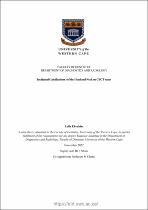| dc.contributor.advisor | Shaik, Shoayeb | |
| dc.contributor.author | Ebrahim, Leila | |
| dc.date.accessioned | 2023-04-21T07:25:27Z | |
| dc.date.available | 2023-04-21T07:25:27Z | |
| dc.date.issued | 2022 | |
| dc.identifier.uri | http://hdl.handle.net/11394/9818 | |
| dc.description | >Magister Scientiae - MSc | en_US |
| dc.description.abstract | One of the most notable additions to the dental imaging armamentarium is the introduction of cone-beam computed tomography (CBCT) scanning in general dental practices. The multi-planar functionality of CBCT allows for accurate localization of structures and pathology and hence minimizes the risk of overlapping of structure images, inherent in conventional two-dimensional radiographs. Additionally, the large image volume acquired in a CBCT scan means that more structures are viewable. Consequently, the chance of finding incidental findings (IFs) is increased. An IF could be defined as any asymptomatic entity/condition/presentation/region that draws the attention of a reporting clinician, with no clinical presentations prior to the primary exam. IFs occur extracranially and intracranially. Idiopathic, dystrophic, or metastatic calcification can affect head and neck structures and also be encountered as incidental findings. | en_US |
| dc.language.iso | en | en_US |
| dc.publisher | University of the Western Cape | en_US |
| dc.subject | Maxillofacial | en_US |
| dc.subject | Dentistry | en_US |
| dc.subject | Radiology | en_US |
| dc.subject | Western Cape | en_US |
| dc.subject | Patient Autonomy | en_US |
| dc.title | Incidental calcifications s of the head and neck on CBCT scans | en_US |
| dc.rights.holder | University of the Western Cape | en_US |

